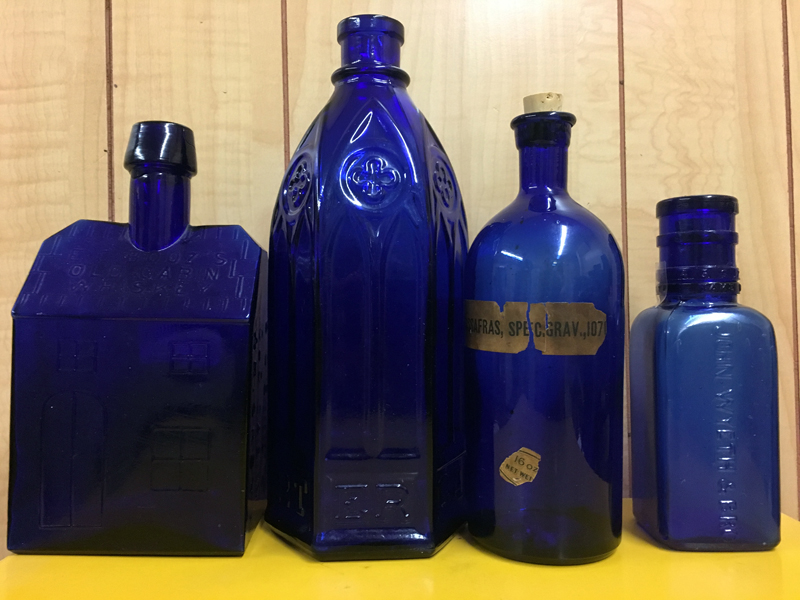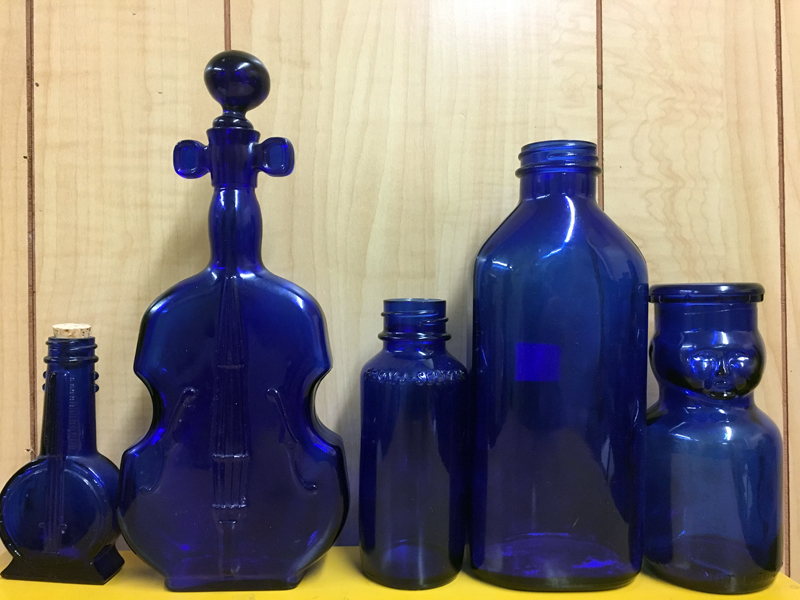
Many people love to collect old cobalt-blue glass bottles, which come in many shapes and sizes.
In this article, we refer back to the year 1961 and recall the joy, companionship, and wonderful hours and weekends we spent with many of our friends about our age looking for old medicine, apothecary, and old drug-store bottles that related to pharmacies and drug stores in Damariscotta as well as Lincoln County.
Just in the town of Damariscotta, from 1856-1981, there have been 14 pharmacies or drug stores on Main Street in Damariscotta and many of their medicine bottles are spread all over the county and throughout the woods and fields where they were disposed of.
The first patent medicine and formulas were registered with the U.S. Patent Office, which opened in 1790. We have found that not all medicines were patented because their procedure required the manufacturer to reveal the true medicine’s content. Here again, we have found that many of these old medicines consisted of liquor diluted with water, and occasionally a drop of opiates, strychnine, and arsenic. If one was able to find one of the medicine bottles with a whole paper label and were able to read it, one would wonder how anyone could survive the recommended doses.
This all changed in 1907 with the passage of the Pure Food and Drug Act. We find that after the passage of the 1907 Pure Food and Drug Act, many of these old patented-medicine companies went out of business and their old bottles became real collectible items and highly sought after.
We spent many joyful hours at Waltz Pharmacy enjoying a cup of hot coffee and talking about old bottles we all had found in the local area. Mrs. Jo-Ann Waltz Jacobs, of Damariscotta, and Mrs. Carol Pottle, of Newcastle, were full of excitement when we would bring in a real old medicine or bitters bottles found here in the local area. We truly miss the both of these local bottle collectors and their lovely smiles and the conversations we had.
Our first Damariscotta medicine bottle is an Asa H. Snow bottle. It is a four-sided clear bottle, 5 ¼ inches high; it has raised letters on one side, “A.H. Snow,” and on the same side near the bottom of the bottle is “Damariscotta.” It is 1 5/8 inches on all four sides and has a few bubbles in the glass. It has a totaled, flanged top and squared edges and a cork stopper to keep the fluid in the bottle; its date is around 1872, when Mr. Snow was in business. This bottle is about 145 years old.
The second bottle is 4 1/8 inches high and is clear glass, blown in a mold, and has embossed letters on one side, which reads “Ges. S. Berry, Damariscotta, ME, druggist.” The bottle is from around 1872 when George S. Berry opened his drug store on Main Street in Damariscotta in the old Austin Block, which burned.
Another bottle is an aqua-colored, round, 4 ¾ inches high, and has embossed letters: “Harris Liniment of Anodyne Damariscotta Me.” This bottle has a few bubbles in the glass and was blown in a mold; it also has a flanged top and square sides and uses a stopper to hold the fluid in the bottle. This Harris Liniment of Anodyne was sold up and down the Damariscotta River. They had a power boat, which was used to peddle the liniment up the Damariscotta River along Midcoast Maine. We have a photo of this boat by the Damariscotta bridge with their advertisement painted on the side of the cabin.

A banjo-shaped bottle (left) and a violin-shaped bottle (second from left) are examples of the variety of old cobalt-blue bottle that collectors treasure.
We found here in our backyard a Peaslee’s Pharmacy bottle from Wiscasset. It is seven inches tall, has a seven-section measure on the side of the bottle, and has “W.B.M. Co.” on the bottom of the bottle, embossed. This bottle used a cork stopper to seal in the liquid. This is a nice collectible pharmacy bottle. We also have a 1908 advertisement with products of Peaslee’s Pharmacy in Wiscasset, which we traded a few weeks ago in exchange for a few bottles the person wanted for his collection from our shop.
This past week while we were having a beverage at Waltz Soda Fountain, a couple of grandmothers came in with some of their grandchildren and they told us how they enjoyed our article on local bottles. They both wanted to know if we could help date some of the local drug-store bottles. So here is some information that may help them and their grandchildren on dates on old drug-store bottles found in this area.
An Asa H. Snow Pharmacy bottle of Damariscotta would date back to 1872, some 145 years old. A George S. Berry Pharmacy bottle is around 1872 and would be around 145 years old. An Erskine & Curtis Pharmacy with embossed letters would date to around 1888. A Smithwick and Curtis would date to 1895-1905. A plain F.L. Smithwick Pharmacy bottle would date around 1905-1943. A Horace T. Poland Pharmacy would date 1922-1946.
We find that in 1944, when F.L. Smithwick went out of business, Mr. R. Martin took over the pharmacy and it was known as Martin’s Rexall Drugs. This became a great place for high-school children to gather after school to enjoy an ice cream or soda. Martin’s Pharmacy closed around 1952.
When Poland’s Pharmacy closed in 1952, Mr. Arnold Briggs took over the pharmacy and it became known as Brigg’s Pharmacy until 1997. Then Mr. David T. Pierce took over the pharmacy in 1997.
Waltz Pharmacy started in Damariscotta in the so-called professional building on Main Street in 1948 and closed its doors on Friday evening, March 30, 2012 as a pharmacy in Damariscotta.
There was also a C.A. Richards Pharmacy, which dated from 1909-1919.
We are both pleased to help date some of these pharmacies in our area for drug-store bottle collectors. It is a great hobby for young and old.
We have found that many people over the past 50 years love to collect “cobalt blue” glass bottles of any type. The dark cobalt glass seems to be an eye-catcher for many men and women. These cobalt blue bottles came in many shapes and sizes.
Some may have no value at all but are very pleasing to the eye and are often placed on windowsills to reflect their beautiful color in the sunlight. These objects come in shapes like figured-skull poison bottles, violin and banjo bottles, bitters bottles, mineral bottles, target balls, inkwells, fire grenades, bottle clocks, cosmetic bottles, and even soda, whiskey, and wine bottles that date back to the 1850s. We also find that many perfume and cologne bottles came in a dark cobalt-blue bottle. My mother always enjoyed Evening in Paris perfume, which came in a small, dark cobalt-blue bottle. Many of the flavorings that were used in candy shops or bakeries came in a dark cobalt bottle in the 1870s through 1910. I also recall that Phillips’ Milk of Magnesia came in a dark cobalt-blue bottle in all sizes from small to large.
A word of caution when digging for old bottles: keep an eye out for poison ivy, hornet nests, and sharp pieces of broken bottles, and always ask the landowners if you can dig or search for old bottles on their land.



